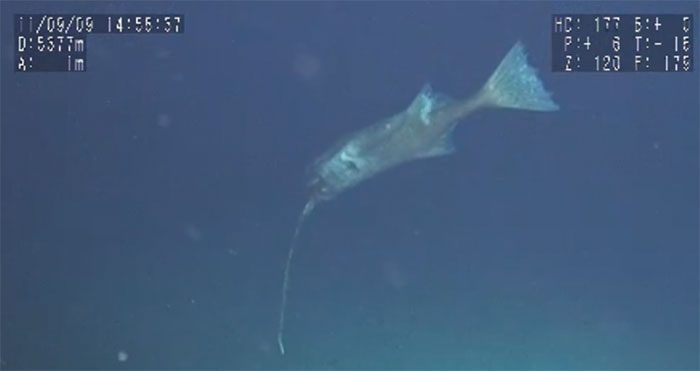Unusual Swimming Posture May Help Lanternfish Snag Prey More Efficiently Without Biting Themselves.
Lanternfish swimming upside down in the water. (Video: Phys.org)
Video evidence from the deep sea shows that some species of lanternfish live their entire lives upside down, according to Pamela Hart, an associate professor at the University of Alabama who studies fish in extreme conditions. This behavior is described in the journal Fish Biology and has exceeded the imagination of scientists, as reported by Phys.org on November 22.
The whipnose lanternfish is a small fish with a fishing rod-like appendage on its face. While their bodies are no larger than a domestic cat, they possess a protruding spine from their nose that is four times the length of their body. Lanternfish deceive other fish with bioluminescent bacteria located at the tip of their lures.

Swimming upside down may make whipnose lanternfish more dangerous.
For nearly a century, scientists believed that whipnose lanternfish dangled their lures in front of them, similar to many of their shorter-appendaged relatives. However, new footage from underwater missions in the Atlantic, Pacific, and Indian Oceans shows that these fish spend their days swimming upside down, trailing their long lures towards the ocean floor. The video confirms a visual observation made more than 20 years ago, according to Stewart.
In 1999, a remotely operated vehicle (ROV) encountered a whipnose lanternfish floating motionless with its belly facing up in waters between Hawaii and California. Researchers suspected they were targeting prey on the ocean floor but could not rule out the possibility that it was just an individual exhibiting unusual behavior.
In a video filmed near the Izu-Ogasawara Trench off the coast of Japan, a whipnose lanternfish drifted with the current, its body parallel to the ocean floor, mouth wide open revealing hundreds of tiny teeth. Suddenly, it made a quick movement, using its powerful tail to swim in tight circles. Eventually, it calmed down and continued to drift before crashing into the ROV’s lighting equipment. It then used its small side fin to retreat into the dark waters. In other videos, propellers and submarine engines made lanternfish tumble and swim with their bellies facing down, but they quickly returned to their upside-down swimming posture.
According to researchers, swimming upside down may make whipnose lanternfish more dangerous. They suspect that by keeping their lures far from their mouths, lanternfish can take down larger prey more quickly and avoid accidentally biting themselves. Stewart once encountered a whipnose lanternfish specimen with a giant squid in its stomach.




















































